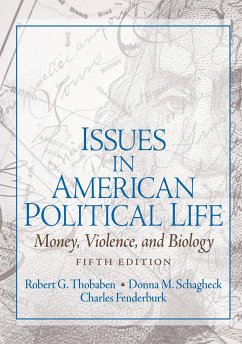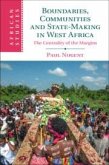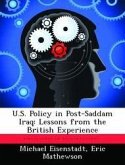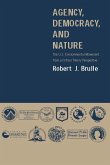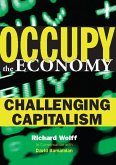A core text for undergraduate courses in American Public Policy, or supplemental reading in such courses as Introduction to American Government or Politics, American Public Policy Analysis, Introduction to Political Science.
A substantive alternative to typical "issues" texts-which cover too many issues, too superficially-this intriguing and comprehensive text offers a more in-depth and coherent approach to contemporary policy problems and solutions. It provides a conceptual framework in which students can become comfortable actually doing policy analysis, and in learning skills beyond reading about certain political issues. Thematically organized, it looks at nine specific issues grouped into three broad categories that hold an enduring importance in American political life-money and politics, violence and politics, and biology and politics. All nine chapters and their respective topics (campaigns, corruption, welfare, crime, terrorism, arms control, the environment, biomedical issues, and biotechnology) have a strong conceptual base with current political dimensions and policy concerns woven throughout. Students not only learn the context, status, and prospects of issues confronting the U.S. government, but also see how these issues now cross our domestic borders into a global realm.
Features + Benefits
An overview of the government and economy.
o Provides students with coverage of this very timely topic.
Chapter on arms control-Emphasizes the spread of weapons of mass destruction.
o Updates new information on this important topic.
Environment chapter.
o Expanded focus on the worldwide population explosion.
Biomedical and biotechnology chapters-Includes discussion of the latest reproductive technologies.
o Provides students with the most current information on this area.
Thematically organized-Divides nine key issues into three categories: money, violence, and biology-the major policy issues confronting American society and government as we begin the millennium.
o Prepares students for the world they live in-where the search for prosperity, progress, and security have been and will continue to be the fundamental social and political values on which America operates.
In-depth examination of each issue-Follows a common organizational structure: 1) discusses the historical background, or "sources"; 2) explores the issue's current "status"; 3) looks at proposals and current "prospects."
o Avoids the typical "all issues for all students" approach and instead provides a conceptual framework in which students can become comfortable actually doing policy analysis, and in learning skills beyond reading about certain political issues.
Comparison of the U.S. and other countries.
o Makes students aware of international trends.
Pedagogical aids-Includes highlighted key terms, study questions, suggested readings, and glossaries.
o Provides convenient in-text study/review aids to keep students motivated and challenged.
Introduction.
I. MONEY AND POLITICS.
1. The Politics of Poverty and the Welfare State.
2. The Politics of Health Care.
3. Money in Public Office: Campaign Finance, Graft, and Corruption.
II. VIOLENCE AND POLITICS.
4. The Politics of Crime in America.
5. The Politics of Terrorism.
6. The Politics of Arms Racing and Weapons of Mass Destruction.
III. BIOLOGY AND POLITICS.
7. Biomedical Issues.
8. Biotechnology.
9. The Ecological Crisis.
Glossary.
Index.
A substantive alternative to typical "issues" texts-which cover too many issues, too superficially-this intriguing and comprehensive text offers a more in-depth and coherent approach to contemporary policy problems and solutions. It provides a conceptual framework in which students can become comfortable actually doing policy analysis, and in learning skills beyond reading about certain political issues. Thematically organized, it looks at nine specific issues grouped into three broad categories that hold an enduring importance in American political life-money and politics, violence and politics, and biology and politics. All nine chapters and their respective topics (campaigns, corruption, welfare, crime, terrorism, arms control, the environment, biomedical issues, and biotechnology) have a strong conceptual base with current political dimensions and policy concerns woven throughout. Students not only learn the context, status, and prospects of issues confronting the U.S. government, but also see how these issues now cross our domestic borders into a global realm.
Features + Benefits
An overview of the government and economy.
o Provides students with coverage of this very timely topic.
Chapter on arms control-Emphasizes the spread of weapons of mass destruction.
o Updates new information on this important topic.
Environment chapter.
o Expanded focus on the worldwide population explosion.
Biomedical and biotechnology chapters-Includes discussion of the latest reproductive technologies.
o Provides students with the most current information on this area.
Thematically organized-Divides nine key issues into three categories: money, violence, and biology-the major policy issues confronting American society and government as we begin the millennium.
o Prepares students for the world they live in-where the search for prosperity, progress, and security have been and will continue to be the fundamental social and political values on which America operates.
In-depth examination of each issue-Follows a common organizational structure: 1) discusses the historical background, or "sources"; 2) explores the issue's current "status"; 3) looks at proposals and current "prospects."
o Avoids the typical "all issues for all students" approach and instead provides a conceptual framework in which students can become comfortable actually doing policy analysis, and in learning skills beyond reading about certain political issues.
Comparison of the U.S. and other countries.
o Makes students aware of international trends.
Pedagogical aids-Includes highlighted key terms, study questions, suggested readings, and glossaries.
o Provides convenient in-text study/review aids to keep students motivated and challenged.
Introduction.
I. MONEY AND POLITICS.
1. The Politics of Poverty and the Welfare State.
2. The Politics of Health Care.
3. Money in Public Office: Campaign Finance, Graft, and Corruption.
II. VIOLENCE AND POLITICS.
4. The Politics of Crime in America.
5. The Politics of Terrorism.
6. The Politics of Arms Racing and Weapons of Mass Destruction.
III. BIOLOGY AND POLITICS.
7. Biomedical Issues.
8. Biotechnology.
9. The Ecological Crisis.
Glossary.
Index.

